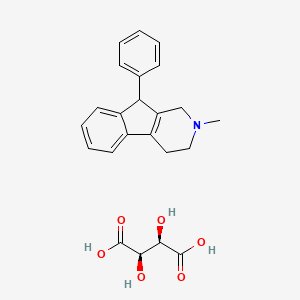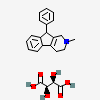Phenindamine Tartrate
PubChem CID
11290
Molecular Formula
Synonyms
- Pernovine
- Phenindamine tartrate
- Phenindamine bitartrate
- Phenindamine tartrate [USAN]
- Nolahist
Molecular Weight
411.4 g/mol
Computed by PubChem 2.1 (PubChem release 2021.05.07)
Component Compounds
Dates
- Create:2005-06-24
- Modify:2025-01-11
Chemical Structure Depiction

Conformer generation is disallowed since mixture or salt
(2R,3R)-2,3-dihydroxybutanedioic acid;2-methyl-9-phenyl-1,3,4,9-tetrahydroindeno[2,1-c]pyridine
Computed by Lexichem TK 2.7.0 (PubChem release 2021.05.07)
InChI=1S/C19H19N.C4H6O6/c1-20-12-11-16-15-9-5-6-10-17(15)19(18(16)13-20)14-7-3-2-4-8-14;5-1(3(7)8)2(6)4(9)10/h2-10,19H,11-13H2,1H3;1-2,5-6H,(H,7,8)(H,9,10)/t;1-,2-/m.1/s1
Computed by InChI 1.0.6 (PubChem release 2021.05.07)
WFXURHIXPXVPGM-LREBCSMRSA-N
Computed by InChI 1.0.6 (PubChem release 2021.05.07)
CN1CCC2=C(C1)C(C3=CC=CC=C23)C4=CC=CC=C4.[C@@H]([C@H](C(=O)O)O)(C(=O)O)O
Computed by OEChem 2.3.0 (PubChem release 2024.12.12)
C23H25NO6
Computed by PubChem 2.1 (PubChem release 2021.05.07)
82-88-2 (Parent)
- 1H-indeno(2,1-c)pyridine, 2,3,4,9-tetrahydro-2-methyl-9-phenyl-, hydrochloride
- Nolahist
- phenindamine
- phenindamine hydrochloride
- phenindamine tartrate
- Thephorin
- Pernovine
- Phenindamine tartrate
- Phenindamine bitartrate
- Phenindamine tartrate [USAN]
- Nolahist
- Pernovin
- Nolahist (TN)
- Phenindamine hydrogen tartrate
- EINECS 209-320-7
- NSC 91526
- 28725X3PV8
- Phenindamine tartrate (USAN)
- UNII-28725X3PV8
- Thephorin tartrate
- PHENINDAMINE TARTRATE [VANDF]
- PHENINDAMINE TARTRATE [MART.]
- 1H-INDENO(2,1-c)PYRIDINE, 2,3,4,9-TETRAHYDRO-2-METHYL-9-PHENYL-, TARTRATE (1:1)
- PHENINDAMINE TARTRATE [WHO-DD]
- 569-59-5
- PHENINDAMINE HYDROGEN TARTRATE [MI]
- 2-Methyl-9-phenyl-2,3,4,9-tetrahydro-1H-indeno(2,1-c)pyridine tartrate
- 1H-Indeno(2,1-c)pyridine, 2,3,4,9-tetrahydro-2-methyl-9-phenyl-, tartrate (1:1) (VAN)
- 1H-Indeno(2,1-c)pyridine, 2,3,4,9-tetrahydro-2-methyl-9-phenyl-, (R-(R*,R*)-2,3-dihydroxybutanedioate (1:1)
- NSC-91526
- PHENINDAMINE TARTRATE (MART.)
- 2,3,4,9-TETRAHYDRO-2-METHYL-9-PHENYL-1H-INDENO(2,1-C)PYRIDINE TARTRATE
- 2,3,4,9-TETRAHYDRO-2-METHYL-9-PHENYL-1H-INDENO-(2,1-C)PYRIDINE BITARTRATE
- 1H-INDENO(2,1-C)PYRIDINE, 2,3,4,9-TETRAHYDRO-2-METHYL-9-PHENYL-, (2R,3R)-2,3-DIHYDROXYBUTANEDIOATE (1:1)
- 1H-INDENO(2,1-C)PYRIDINE, 2,3,4,9-TETRAHYDRO-2-METHYL-9-PHENYL-, (R-(R*,R*))-2,3-DIHYDROXYBUTANEDIOATE (1:1)
- SCHEMBL141590
- AKOS040753493
- 2,3,4,9-Tetrahydro-2-methyl-9-phenyl-1H-indeno(2,1-c)pyridine L-(+)-tartrate (1:1)
- HY-129783
- NS00080033
- D02148
- Q27254278
- 2-methyl-9-phenyl-2,3,4,9-tetrahydro-1H-indeno[2,1-c]pyridine, tartrate salt
- (2R,3R)-2,3-dihydroxybutanedioic acid;2-methyl-9-phenyl-1,3,4,9-tetrahydroindeno[2,1-c]pyridine
- 1H-Indeno(2,1-c)pyridine, 2,3,4,9-tetrahydro-2-methyl-9-phenyl-, tartrate (1:1) (VAN) (8CI)
- 2-methyl-9-phenyl-2,3,4,9-tetrahydro-1H-indeno[2,1-c]pyridin-2-ium;2,3,4-trihydroxy-4-oxobutanoate
Property Name
Property Value
Reference
Property Name
Molecular Weight
Property Value
411.4 g/mol
Reference
Computed by PubChem 2.1 (PubChem release 2021.05.07)
Property Name
Hydrogen Bond Donor Count
Property Value
4
Reference
Computed by Cactvs 3.4.8.18 (PubChem release 2021.05.07)
Property Name
Hydrogen Bond Acceptor Count
Property Value
7
Reference
Computed by Cactvs 3.4.8.18 (PubChem release 2021.05.07)
Property Name
Rotatable Bond Count
Property Value
4
Reference
Computed by Cactvs 3.4.8.18 (PubChem release 2021.05.07)
Property Name
Exact Mass
Property Value
411.16818752 Da
Reference
Computed by PubChem 2.1 (PubChem release 2021.05.07)
Property Name
Monoisotopic Mass
Property Value
411.16818752 Da
Reference
Computed by PubChem 2.1 (PubChem release 2021.05.07)
Property Name
Topological Polar Surface Area
Property Value
118 Ų
Reference
Computed by Cactvs 3.4.8.18 (PubChem release 2021.05.07)
Property Name
Heavy Atom Count
Property Value
30
Reference
Computed by PubChem
Property Name
Formal Charge
Property Value
0
Reference
Computed by PubChem
Property Name
Complexity
Property Value
524
Reference
Computed by Cactvs 3.4.8.18 (PubChem release 2021.05.07)
Property Name
Isotope Atom Count
Property Value
0
Reference
Computed by PubChem
Property Name
Defined Atom Stereocenter Count
Property Value
2
Reference
Computed by PubChem
Property Name
Undefined Atom Stereocenter Count
Property Value
1
Reference
Computed by PubChem
Property Name
Defined Bond Stereocenter Count
Property Value
0
Reference
Computed by PubChem
Property Name
Undefined Bond Stereocenter Count
Property Value
0
Reference
Computed by PubChem
Property Name
Covalently-Bonded Unit Count
Property Value
2
Reference
Computed by PubChem
Property Name
Compound Is Canonicalized
Property Value
Yes
Reference
Computed by PubChem (release 2021.05.07)
Follow these links to do a live 2D search or do a live 3D search for this compound, sorted by annotation score. This section is deprecated (see here for details), but these live search links provide equivalent functionality to the table that was previously shown here.
Same Connectivity Count
Mixtures, Components, and Neutralized Forms Count
Similar Compounds (2D)
Similar Conformers (3D)
Same Count
Gene Count
Histamine H1 Antagonists
Drugs that selectively bind to but do not activate histamine H1 receptors, thereby blocking the actions of endogenous histamine. Included here are the classical antihistaminics that antagonize or prevent the action of histamine mainly in immediate hypersensitivity. They act in the bronchi, capillaries, and some other smooth muscles, and are used to prevent or allay motion sickness, seasonal rhinitis, and allergic dermatitis and to induce somnolence. The effects of blocking central nervous system H1 receptors are not as well understood. (See all compounds classified as Histamine H1 Antagonists.)
Patents are available for this chemical structure:
https://patentscope.wipo.int/search/en/result.jsf?inchikey=WFXURHIXPXVPGM-LREBCSMRSA-N
- CAS Common ChemistryLICENSEThe data from CAS Common Chemistry is provided under a CC-BY-NC 4.0 license, unless otherwise stated.https://creativecommons.org/licenses/by-nc/4.0/Phenindamine tartratehttps://commonchemistry.cas.org/detail?cas_rn=569-59-5
- ChemIDplusPhenindamine tartrate [USAN]https://pubchem.ncbi.nlm.nih.gov/substance/?source=chemidplus&sourceid=0000569595ChemIDplus Chemical Information Classificationhttps://pubchem.ncbi.nlm.nih.gov/source/ChemIDplus
- European Chemicals Agency (ECHA)LICENSEUse of the information, documents and data from the ECHA website is subject to the terms and conditions of this Legal Notice, and subject to other binding limitations provided for under applicable law, the information, documents and data made available on the ECHA website may be reproduced, distributed and/or used, totally or in part, for non-commercial purposes provided that ECHA is acknowledged as the source: "Source: European Chemicals Agency, http://echa.europa.eu/". Such acknowledgement must be included in each copy of the material. ECHA permits and encourages organisations and individuals to create links to the ECHA website under the following cumulative conditions: Links can only be made to webpages that provide a link to the Legal Notice page.https://echa.europa.eu/web/guest/legal-noticePhenindamine tartratehttps://echa.europa.eu/substance-information/-/substanceinfo/100.008.474
- FDA Global Substance Registration System (GSRS)LICENSEUnless otherwise noted, the contents of the FDA website (www.fda.gov), both text and graphics, are not copyrighted. They are in the public domain and may be republished, reprinted and otherwise used freely by anyone without the need to obtain permission from FDA. Credit to the U.S. Food and Drug Administration as the source is appreciated but not required.https://www.fda.gov/about-fda/about-website/website-policies#linkingPHENINDAMINE TARTRATEhttps://gsrs.ncats.nih.gov/ginas/app/beta/substances/28725X3PV8
- KEGGLICENSEAcademic users may freely use the KEGG website. Non-academic use of KEGG generally requires a commercial licensehttps://www.kegg.jp/kegg/legal.htmlAnatomical Therapeutic Chemical (ATC) classificationhttp://www.genome.jp/kegg-bin/get_htext?br08303.kegTarget-based classification of drugshttp://www.genome.jp/kegg-bin/get_htext?br08310.keg
- NCI Thesaurus (NCIt)LICENSEUnless otherwise indicated, all text within NCI products is free of copyright and may be reused without our permission. Credit the National Cancer Institute as the source.https://www.cancer.gov/policies/copyright-reuseNCI Thesaurushttps://ncit.nci.nih.gov
- Springer Nature
- Wikidataphenindamine tartratehttps://www.wikidata.org/wiki/Q27254278
- PubChem
- Medical Subject Headings (MeSH)LICENSEWorks produced by the U.S. government are not subject to copyright protection in the United States. Any such works found on National Library of Medicine (NLM) Web sites may be freely used or reproduced without permission in the U.S.https://www.nlm.nih.gov/copyright.htmlphenindaminehttps://www.ncbi.nlm.nih.gov/mesh/67005430Histamine H1 Antagonistshttps://www.ncbi.nlm.nih.gov/mesh/68006634
- NORMAN Suspect List ExchangeLICENSEData: CC-BY 4.0; Code (hosted by ECI, LCSB): Artistic-2.0https://creativecommons.org/licenses/by/4.0/NORMAN Suspect List Exchange Classificationhttps://www.norman-network.com/nds/SLE/
- PATENTSCOPE (WIPO)SID 388414930https://pubchem.ncbi.nlm.nih.gov/substance/388414930
CONTENTS

 CID 11291 (Phenindamine)
CID 11291 (Phenindamine) CID 444305 (L-Tartaric acid)
CID 444305 (L-Tartaric acid)